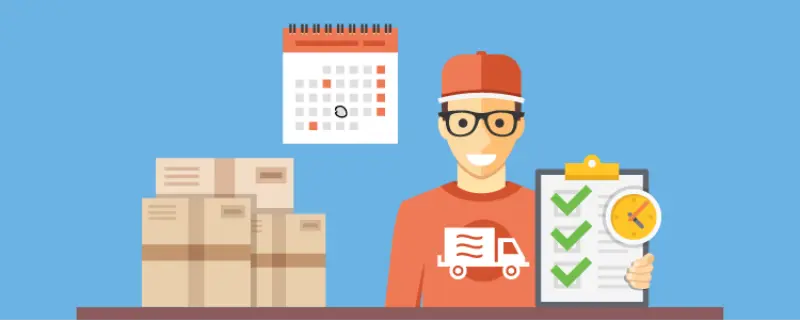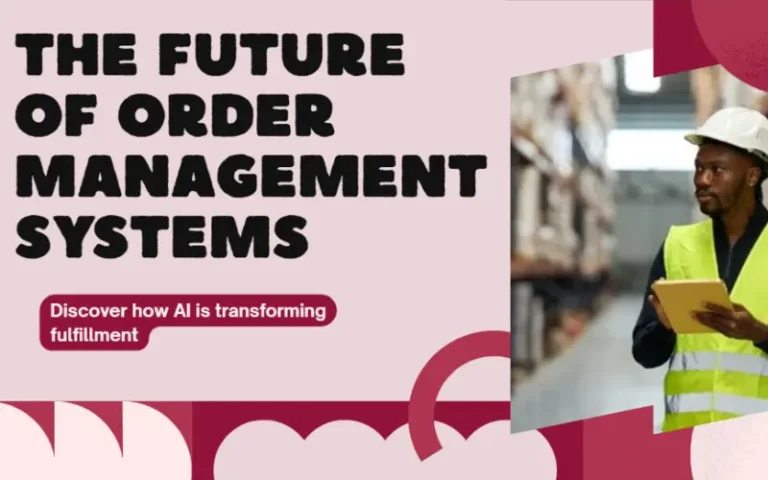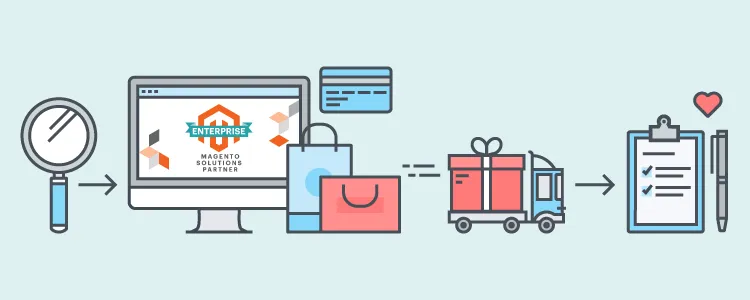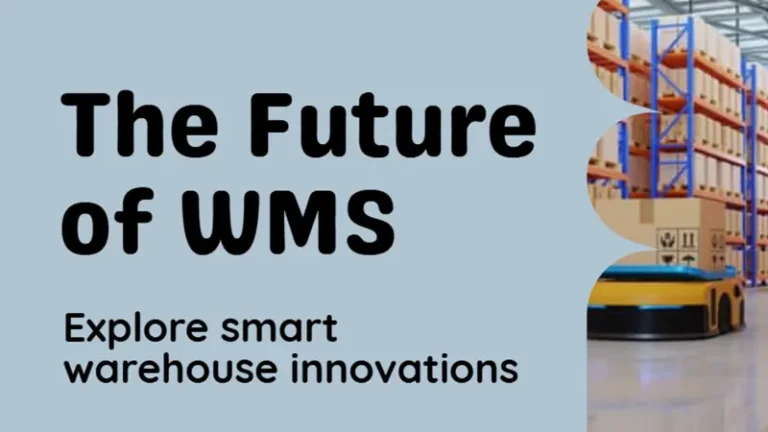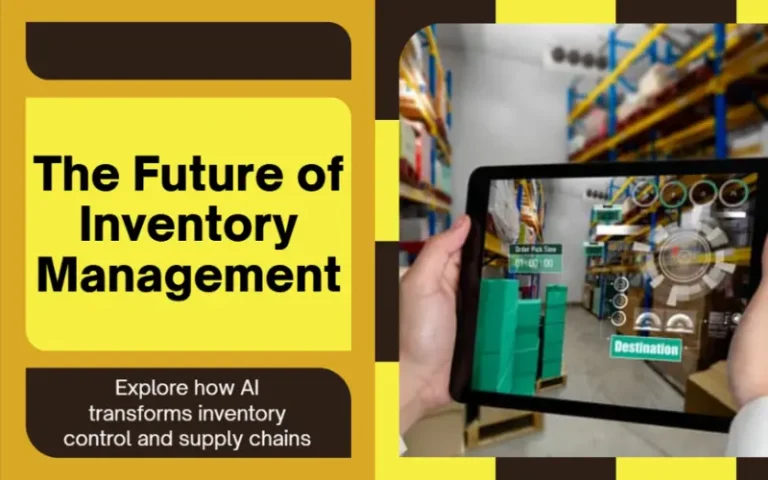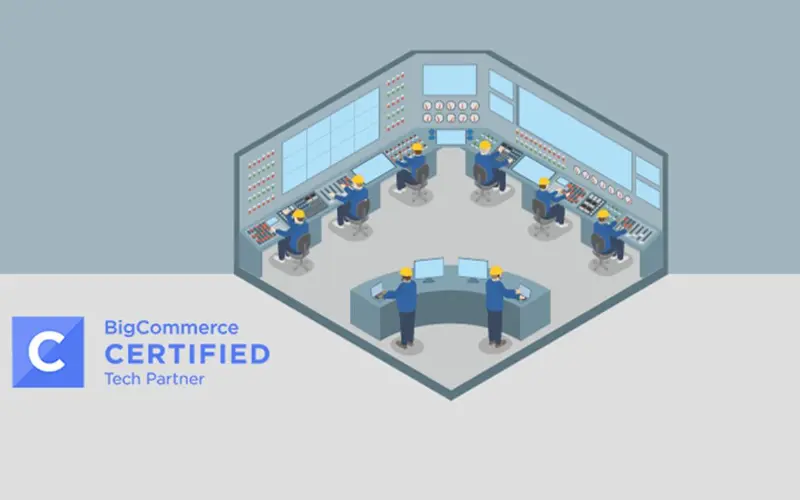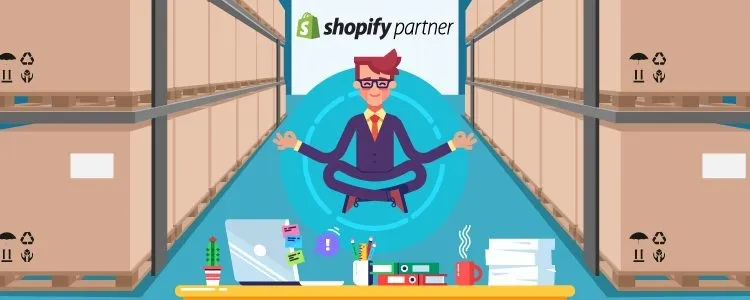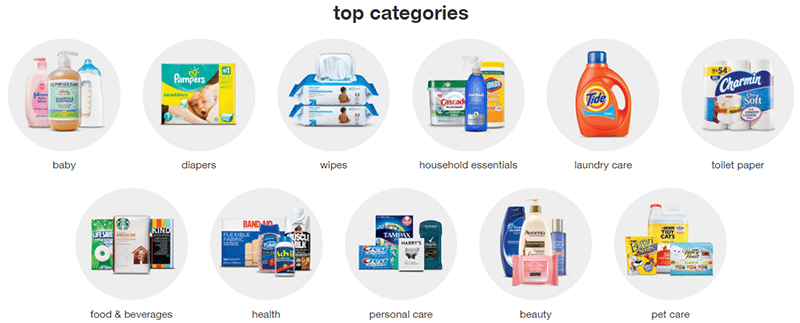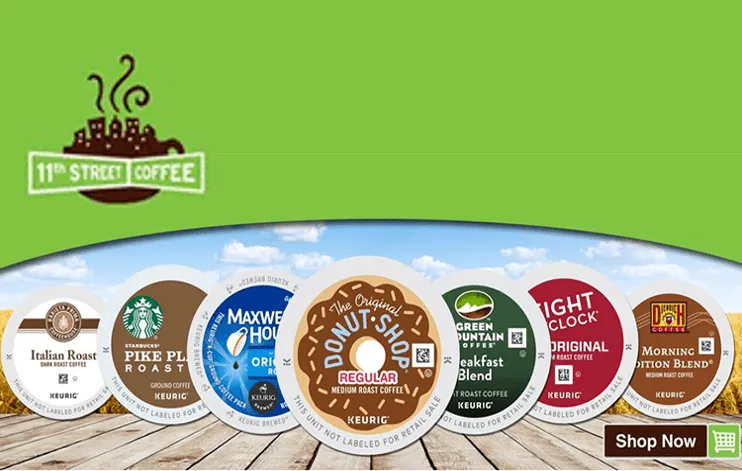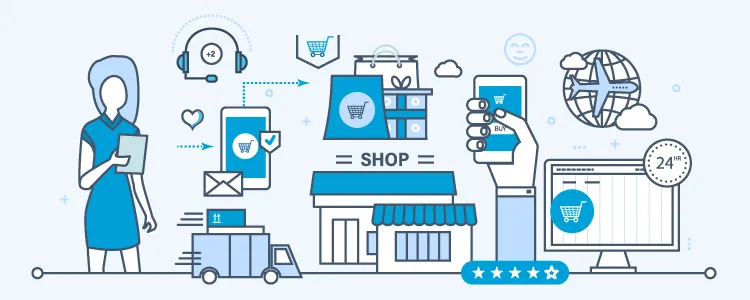Why Online Retailers Must Offer Date-Certain Shipping This Holiday Season
In this article
 6 minutes
6 minutes
- Act now to reduce your accessorial charges and return rates
- Deterministic shipping can help you improve customer service too
- Upgrade your customer experience and brand perception this holiday season
- Act fast and implement these strategies to claim your holiday gift early
- How to go about implementing these strategies and tactics
- An Order Management System (OMS) with robust integration can
We have come a long way on the journey from the Pony Express to Federal Express
From: “I wonder if the courier died?”
|
To: “FedEx received the Package”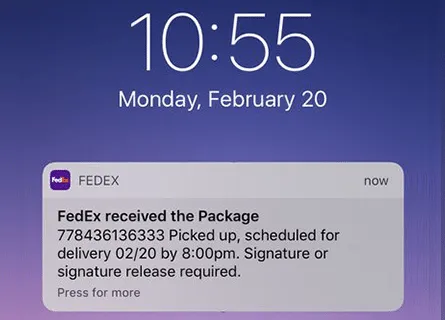
|
FedEx, UPS, and even the US Postal Service, provide their customers with real-time shipment updates. They also give merchants access to many shipping service types – next day, 2-day, 3-day, ground, and more.
Similarly, online retailers can and should offer choices to their customers. For example, Amazon gives customers multiple date-certain delivery choices, also known as Date-Certain Shipping or Deterministic Shipping, leaving those who don’t at a competitive disadvantage.
Over 65 million Amazon Prime members are presented with these options, and an increasing number of fast followers are adopting similar strategies, leaving those who don’t at a competitive disadvantage.
Slash Your Fulfillment Costs by Up to 30%
Cut shipping expenses by 30% and boost profit with Cahoot's AI-optimized fulfillment services and modern tech —no overheads and no humans required!
I'm Interested in Saving Time and MoneyAt Pulse Commerce, we believe that Amazon has made date-certain shipping an ecommerce imperative. Merchants who offer deterministic shipping, especially during the holidays, will enjoy higher conversion rates and sales than those who do not.
Given that Amazon spent $16.2 Billion on shipping expenses in 2016 alone, we can be certain that it has cracked the shopping cart conversion code better than anyone else, especially when it comes to shipping and fulfillment.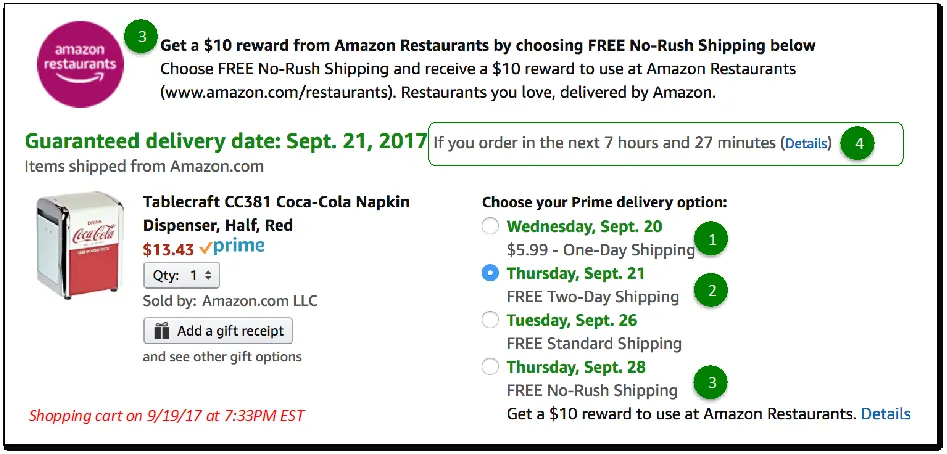
Let’s examine this shopping cart (see Figure 1), observe the tactics being used, and consider their impact on both consumers and the merchant:
- Choices increase conversion: This Amazon Prime customer is presented with four choices; including (1) receive tomorrow for an additional $5.99 and (2) receive in 2 days at no charge. According to a Metapack study, 61% of customers bought goods from one retailer over another because they provided more delivery options.
- Customer incentives reduce shipping expense: If a customer chooses option (3) FREE No-Rush Shipping, they receive $10 towards Amazon Restaurants. Amazon regularly offers its customers incentives to help cut down its massive $16.2B shipping expense. This offer is not random – it’s part of a broader strategy to attract new users to Amazon Restaurants. Take a trip to Amazon Restaurants, and here’s the first thing we see:
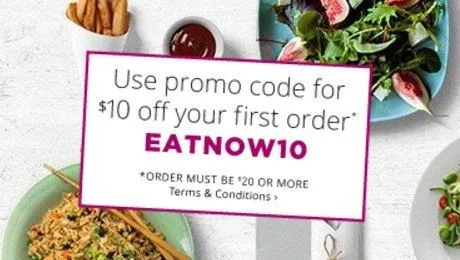
- Urgency increases conversion: Look at option (4) in the illustration above. The customer is guaranteed delivery by September 21 (2 days) if she purchases in the next 7 hours 27 minutes. As the customer is looking at their cart, that clock is ticking down, second-by-second, shouting “buy me now if you need me by Thursday!”
This simple cart message increases conversion by giving clear and specific choices and creating a sense of urgency. It also reduces shipping expenses for the merchant by rewarding customers who choose the least expensive shipping option.
Act now to reduce your accessorial charges and return rates
By giving Date-Certain Shipping options, Amazon is reducing a few of their accessorial charges (surcharges imposed by the carriers) as well. Choosing a delivery date reduces the number of unsuccessful deliveries, which reduces Delivery Reattempt fees and expenses.
Looking for a New 3PL? Start with this Free RFP Template
Cut weeks off your selection process. Avoid pitfalls. Get the only 3PL RFP checklist built for ecommerce brands, absolutely free.
Get My Free 3PL RFPWhen customers know when the package will arrive at the time of ordering, they know when to expect the package. They are not disappointed as long as the delivery date commitment is met. This minimizes the number of returns from the customer due to shipping related uncertainty.
Deterministic shipping can help you improve customer service too
Timely and accurate delivery status updates reduce Where is My Order (WISMO) customer service calls, especially during the holiday surge.
- Where Is My Order customer service requests can generate upwards of 70% of all customer inquiries during the holidays (source: getelastic).
- Frequent and easily available updates can cut WISMO calls by 50% or more.
- You can reduce overall customer inquiries by 10% to 30%, freeing up CSRs to respond to inquiries that require their expertise.
Upgrade your customer experience and brand perception this holiday season
![]()
If carriers can provide real-time status updates on their websites, then you can for your customers too – online, and via app notification, email and SMS.
- Provide a branded order tracking page and include links to it on all prominent pages
- Provide a link to online package tracking in your shipping notification emails
- Send an email to the customer when the order is in-transit, out for delivery and when it’s delivered
- Display a “where is my order” link on your customer service page
- Over-communicate delivery timeframes – include estimated delivery dates info on all relevant emails and web pages
Scaling Made Easy: Calis Books’ Fulfillment Journey
Learn how Calis Books expanded nationwide, reduced errors, grew sales while cutting headcount, and saved BIG with Cahoot
See Scale JourneyAct fast and implement these strategies to claim your holiday gift early
We’ve outlined several initiatives that can increase holiday conversions and customer satisfaction while reducing shipping costs. You must invest early to bring these initiatives to life, so you can maximize your ROI this holiday season.
- Provide date-certain shipping choices on product details and shopping cart pages (i.e. deterministic shipping) to increase conversion
- Create urgency to order now (to receive by specific date) to increase conversion
- Reward customers for choosing later delivery to reduce Shipping Expense
- Provide frequent and prominent order tracking updates on your website and through email to reduce WISMO calls, increase satisfaction, and lower customer service costs
How to go about implementing these strategies and tactics
The answer lies in technology. Modern order management software, like Pulse Commerce’s, that has deep real-time integration with shipping carriers like UPS, USPS, FedEx, etc. can easily enable date-certain shipping for merchants.
You might consider integrating directly using each carrier’s API. While shipment tracking information is crucial, that’s not all. You also need accurate, real-time information on:
- Item fulfillment (i.e. is the item in stock)
- Which warehouse or store will the item ship from
- The cut-off time for order processing by sales channel and fulfillment location before it’s picked, packed and scheduled for UPS or FedEx to pick up.
Most if not all this information typically resides in an order management system, which may also house the product catalog and inventory data.
An Order Management System (OMS) with robust integration can:
- Integrate with all popular shipping carriers and ecommerce platforms, reducing complexity.
- Track orders from source to customer’s doorstep, and provide proactive alerts on exceptions.
- Enable you to expose this information to customers through many formats: (1) automated email and SMS notifications; and (2) real-time branded tracking on website or mobile apps.
An OMS does much more, including intelligent order routing to turn orders around faster while optimizing inventory. You can learn more about the broad role that an OMS plays in the enterprise, by reading this article on Order Management Essentials.
Turn Returns Into New Revenue
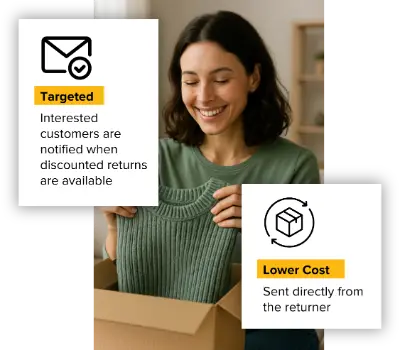
Why Mid-Market Magento Merchants Need Distributed Order and Inventory Management Software
In this article
 7 minutes
7 minutes
- Introduction
- Magento’s Role In the Ecommerce Battlefield
- Magento Storefronts Live in a Vibrant Developer Ecosystem
- Why is a Distributed Order and Inventory Management Platform Needed a Growth and Scale?
- The New Role of an Inventory Management and Order Fulfillment Platform
- The Benefits of Deep, Certified Magento Integration
- Robust APIs and Certified Magento Integration
Introduction
Magento Open Source Ecommerce Platform is an important player in today’s Amazon vs. everyone ecommerce battlefield. With a large contingent of Magento developers, spread across thousands of companies, the pace and depth of product development is orders of magnitude higher than any merchant could muster on their own.
Magento focuses on the core platform capabilities, while an ecosystem of Magento certified software companies and individuals focus on building extensions and themes in categories like marketing, analytics, site optimization, SEO/SEM, customer support, accounting and finance, order and inventory management, warehouse management, and many other functions. This vibrant combination of extensions, themes and partners extend the Magento solution to do more, a lot more. Magento clients benefit handsomely by this distributed product development marketplace.
Order fulfillment and inventory management are two of the most critical back-office functions in ecommerce. These two capabilities are at the core of customer satisfaction and profitability. Pulse Commerce, a cloud-based, Magento certified order and inventory management platform, has filled that gap, and has a deep native integration with Magento.
Continue reading to learn:
- Magento’s role as a software vendor in the ecommerce battlefield
- The Magento developer ecosystem
- Order & Inventory Management’s (OMS) role in growth, profitability and customer loyalty
- The advantages of deploying a certified Magento OMS Integration
Magento’s Role In the Ecommerce Battlefield
In the ecommerce war, there’s Amazon… and then there’s everyone else. Among the top 50 ecommerce retailers, Amazon captured over 50% of all ecommerce revenue in 2016 — 530x more revenue than #50 and 6.5x more than Wal-Mart!
Magento Open Source (formerly Magento Community Edition) and Magento Commerce (formerly Magento Enterprise Edition) are important weapons in this ecommerce battlefield. Their open-source software democratizes ecommerce technology with a powerful platform, rich features, a virtually unlimited ability to customize, extend and scale. Including their cloud-based solutions, Magento Pro and Magento Starter, it powers over 250,000 ecommerce storefronts globally.
Magento Storefronts Live in a Vibrant Developer Ecosystem
Organizations running Magento Open Source Edition typically have the need and the resources to control all aspects of their ecommerce front-end user experience. At the same time, they have little motivation or business need to re-create the back-office. For example, you’d be hard pressed to find a $100mm retailer writing their own proprietary accounting software.
Magento, with its open source software licensing model, provides everyone else an ecommerce platform that that has an army of over 150,000 mercenary developers globally, continuously improving and adding new extensions to their already feature-rich platform. Magento enables everyone else to band together and create a better platform for all Magento users.
While front-end interfaces will likely evolve, and change in ways we cannot imagine, Magento’s certified partners, like Pulse Commerce are building and integrating best-of-breed back office tools that merchants have little need to customize. That accounting software, for example. Order and Inventory Management is another example.
At Pulse Commerce, we’ve found that companies without an enterprise order and inventory management platform can’t scale efficiently as they cross through the $10 to $20mm mark on their way to $500mm.
Why is a Distributed Order and Inventory Management Platform Needed a Growth and Scale?
Growth introduces new complexities that a light order management system can’t address.
- Additional sales channels (e.g. marketplaces) put pressure on fulfillment. Without a holistic, single view of all orders across all channels, it’s harder to track orders in danger of shipping late. Fulfillment centers are more likely to introduce errors or get backlogged.
- Additional vendors and SKUs, coupled with additional sales channels, often transform product information management from an afterthought into a bottleneck. Without automation, information must be added to multiple systems in myriads of formats.
- More fulfillment options make it harder to have real-time visibility into overall inventory and location-specific inventory. Without an up-to-the-minute view, more stockouts occur or more capital is tied up in overstock.
- Together, these growth complexities hamper customer support. As more channels and fulfillment options are added, CSRs may need better tools to streamline issue escalation processes. Also, without good technology support, CSRs may have to switch between multiple software applications to resolve customer questions and complaints.
- For merchants seeking to add omnichannel services, new capabilities are difficult to implement without a centralized real-time view of orders and inventory. For example, you can’t launch a buy online pickup in store (BOPIS) program because the ecommerce system has now way of ‘knowing’ the available inventory at any particular store.
The New Role of an Inventory Management and Order Fulfillment Platform
Core capabilities begin with a synchronized real-time view of all orders, inventory, customers, products and promotions across all sales channels and all fulfillment centers.
- Distributed Order Management begins with intelligent order routing, and ends with higher inventory turns, faster order turnaround, lower shipping costs, and higher customer satisfaction.
- Routes orders to the fulfillment center with the most inventory to increase turns
- Routes orders to the fulfillment center closest to the customer to save on shipping
- Enables customers to buy an out of stock item on backorder. Or pre-order a new product before it’s available for sale
- Increases efficiency with capabilities for order splitting, returns / reverse logistics, recurring subscription orders (e.g. a monthly recurring coffee order)
- Omnichannel fulfillment gives customers a seamless experience as they interact with your brand across multiple channels.
- Omnichannel customers can buy online and pickup in store because your Magento platform has access to real-time store-level, sku-level inventory.
- CSRs can resolve issues quickly, logging into one system to see what was purchased and where, and make suggestions such as, “you can exchange it at the local store on 123 Main Street for the blue shirt. We’ve already put it on hold for you there.”
- For an ecommerce customer, an order for an item that’s out of stock in the fulfillment center can be routed to a store with the item on hand to ship from the store.
- Multi-location shipping, drop-shipping and EDI integration, certified UPS, USPS and FedEx integration streamline fulfillment and vendor management
- Inventory Management is a key to profitability.Consider a company with $25mm in annual revenue, and a 40% cost of goods sold. If inventory turns are 5.0, then, on average, $2mm+ inventory is required. If inventory turns are 10.0, then only $1mm inventory is required, on average. That’s $1mm (4% of revenue) in additional cash in the bank.
- Real-time visibility of company-wide inventory powers Omnichannel capabilities.
- With a real-time view of days of inventory, you can proactively reduce stockouts, reduce overstock and increase cash flow.
- Payments and Risk Management is your lifeblood. Delayed payments hurt cash flow, and fraudulent transactions increase chargebacks and distract your company from real customers.
- An enterprise OMS performs fraud checks and streamlines PCI compliance and reporting
- You’ll get paid for online store purchases faster, and have support for all leading payment options.
- Reporting and Analytics can change the trajectory of your business. Insights gained from drilling deep into your data (orders, inventory, customers, products, and promotions) helps identify opportunities as well as areas to fix. For example:
- Sales and Order data at the company, channel, store, sku, and item levels – compared to prior period, prior year, and forecast.
- Visibility into shipping costs, returns (by channel, store, product, fulfillment center)
- Promotion ROI calculation
- Exception reports, such as SKUS with less than 10 days of inventory in stock.
The Benefits of Deep, Certified Magento Integration
A cloud-based enterprise OMS, sitting outside the Magento technology stack, provides all the value we’ve outlined above, while also reducing the risk of having all your technology eggs in one basket.
Robust APIs and Certified Magento Integration:
- Enables your tech team to stay focused on the core ecommerce capabilities without having to manage back-office technology
- Reduces complexity in adding new marketplaces, sales channels, shippers, payment options and more
- Maintains a cloud data repository outside your ecommerce platform, reducing operational risk.
- Accelerates implementation and time to market.
Pulse Commerce’s Magento Certified Order and Inventory Management Platform brings all of the capabilities discussed in this post, and much more to Magento customers. We’re proud to be members of the everybody else community, helping mid-market merchants compete, win, and grow. Contact Sales today for a free demo or a no-obligation consultation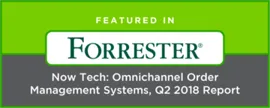

Turn Returns Into New Revenue

BigCommerce Enterprise Order & Inventory Management Software
Since BigCommerce’s 2009 launch, nearly 100,000 stores have earned over $8B through the platform. With BigCommerce running the ecommerce platform technology in the cloud with seamless upgrades, merchants can focus more on the areas they know best – merchandising, pricing, promotion, and product assortment management, to name a few.
This focus has fueled growth for thousands of online merchants. If you’re one of BigCommerce Enterprise’s success stories, you may find that operations that were in perfect sync while generating $5mm in annual revenue can’t keep up anymore as sales pass through the $10mm mark.
Two areas where growth hits operations hardest are also important drivers of your customer satisfaction and profitability:
- Order fulfillment; and
- Inventory management
Order fulfillment and inventory management processes must adapt and change as sales volume increases.
Growth is hard work! And when your business is feeling growing pains, it can be hard to figure out exactly which processes need the most change to help your business scale.
Slash Your Fulfillment Costs by Up to 30%
Cut shipping expenses by 30% and boost profit with Cahoot's AI-optimized fulfillment services and modern tech —no overheads and no humans required!
I'm Interested in Saving Time and Money5 Symptoms of Tired Order Fulfillment and Inventory Management Processes
Through our own work with BigCommerce and hundreds of other merchants, we’ve seen five common symptoms that inform that it’s time to upgrade order fulfillment and inventory management processes:
Symptom 1: Late shipments increase as new sales channels are added
- Fulfillment centers get bogged down with inbound orders from multiple sales channels.
- You don’t have a pulse on which orders are in danger of shipping late – with multiple systems you don’t have a single view of all orders.
Symptom 2: Slower time to market and higher returns
- As the product sku count increases, so does the amount of product information to manage.
- As you add more channels (e.g. online marketplaces), product information must be added to multiple systems in myriad of formats.
Symptom 3: More stock outs or capital tied up in overstock
Your order management system lacks real-time visibility into inventory – e.g. inbound, outbound and in-transit inventory – creating inefficiencies:
- Orders get routed to fulfillment centers or stores that are low on stock, instead of those that have excess inventory.
- Sometimes items appear to be out of stock, but are actually available through different fulfillment centers, drop-ship vendors or brick-and-mortar stores.
Symptom 4: Slower customer service with fewer delighted customers
- As you add channels and fulfillment centers, CSRs have to switch between multiple software applications and business processes to resolve customer questions and complaints. CSRs may also be overburdened by the sheer volume of inquiries or not have streamlined issue escalation processes that are needed at a larger volume company growth stage.
Symptom 5: Unable to offer true omnichannel experiences
- Buying online and returning to a store can a clunky process if your Point-of-Sale software doesn’t have access to the ecommerce orders.
- You may have excess inventory in stores, and you’d like to route ecommerce orders to ship-from-store – but your systems don’t support it yet.
- You may have difficulty managing a buy online, pick up in store (BOPIS) program because your online and store systems don’t communicate very well or in real-time.
Looking for a New 3PL? Start with this Free RFP Template
Cut weeks off your selection process. Avoid pitfalls. Get the only 3PL RFP checklist built for ecommerce brands, absolutely free.
Get My Free 3PL RFP4 Benefits of Adding an Order and Inventory Management Software to your BigCommerce Store
BigCommerce Enterprise Order and Inventory Management Software by Pulse Commerce eliminates these symptoms while enabling scalable growth.
It all starts with a real-time 360-degree view of orders and inventory.
The OMS synchronizes data from your commerce systems, enabling automated business decisions with real-time data. Every order, all inventory, customer history, promotions and product information are centralized within the OMS – so you can process higher order volume across more sales channels and fulfillment options. Benefits include:
1. Better cash flow through higher inventory turns
You can track inventory turns and profitability by vendor, by Sku, or by category. And, you can drill down into this view by store, by channel, or zoom out at the company level.
You can also make smarter purchasing decisions – e.g. ordering items mid-season that you know will sell out before the next purchasing cycle.
2. Faster shipments and reduced costs via intelligent order routing
Deliver orders faster while cutting shipping costs by having the OMS select the order fulfillment center closest to the customer. Shipping costs can be reduced 10% to 20% using this strategy, while shaving a day or more off of delivery times.
Reduce overall cost of inventory by having the OMS route orders to optimize inventory – for example, fulfilling from the store or the fulfillment center with the highest days of inventory on hand.
3. Quicker onboarding of new vendors and products while minimizing errors
Your BigCommerce product information format requirements may be different from those of marketplaces and comparison shopping engines. Entering the same data multiple times in different formats wastes time and increases the error rate.
Pulse Commerce’s Order and Inventory Management for BigCommerce manages that for you. Enter the information once, and then simply map the product content to the various templates once.
4. Better customer support and faster issue resolution
Without an OMS, your CSRs may have to log into multiple systems to handle a simple inquiry. For example, logging in to BigCommerce and a POS to find a purchase record, then your inventory management system to ensure an item is in stock in the fulfillment center or a store and then an email program on when the new stock might be arriving to what locations.
A modern OMS like Pulse Commerce’s provides all of that information in one place, and empowers the CSR to resolve the issue without unwanted switching costs and delays.
Issues are resolved faster. Customers are happier, CSRs are happier, and your CFO is happier too.
You can get a better sense for the financial benefits of an OMS by reviewing our Order Management System ROI Calculator. And, it’s prudent to know that all order and inventory management software are not created equal. You can also gain insight into the pitfalls of a “light” OMS by reading The 9 Deadly Sins of a Light Order Management System.
To learn more about how an OMS can benefit BigCommerce merchants, contact Pulse Commerce Sales to schedule your personalized 1-on-1 demo. If you are a Shopify Plus or a Magento merchant, we have good news for you too.
One of the critical deciding factors when selecting PULSE Commerce was after we evaluated at least a half-dozen leading cloud solutions we found Pulse Commerce to be the best Mid-Market Order and Inventory Management System tightly integrated with BigCommerce that offered all the features and capabilities that we need to scale and support sales through multiple channels, as well as to unify our BigCommerce website, call center and our Point-of-Sale (POS).
We found Pulse Commerce technology to be solid, their professionalism refreshing and technical support super responsive. I feel they are committed to our success which goes beyond just software features and functionality.
~Pat Murray
Director, Congregation of the Sisters of St. Joseph

Turn Returns Into New Revenue

Order and Inventory Management Software for Shopify Plus Brings Zen to the Back-Office
Shopify Plus Order and Inventory Management Software
The Shopify Plus retailer roster is full of inspiring stories of high growth merchants. While every merchant is using the same Shopify technology platform for their ecommerce storefront, their growth stories are all different. Different categories, different merchandising strategies, different marketing and pricing tactics.
As is the case for all other businesses, retailers have to adapt as they grow. Processes that work well at the $5mm annual revenue mark typically begin to break down as retailers approach doubling in size.
High growth typically causes order fulfillment and inventory management processes to buckle under the pressure of higher volume and more complex operations.
Following are the other common growth initiatives that can stretch fulfillment and inventory management processes within an organization – challenges that require a technology upgrade in order to scale.
Slash Your Fulfillment Costs by Up to 30%
Cut shipping expenses by 30% and boost profit with Cahoot's AI-optimized fulfillment services and modern tech —no overheads and no humans required!
I'm Interested in Saving Time and MoneyGrowth Initiative
Addition of new sales channels:
Marketplaces, Brick & mortar stores, Popup Stores
Challenges
Late Shipments and More Returns
- How will fulfillment centers manage inbound orders from multiple sales channels with varying service level requirements?
- How will marketing ensure that product information is consistent across channels, each with its own set of rigid format?
Growth Initiative
Addition of new warehouses and fulfillment centers
Challenges
More Stockouts or Capital Tied up in Overstock
- How will you intelligently route orders to the ideal fulfillment center? Which center has the most inventory? How to maximize the purchase and distribution of stock to maximize return on capital?
- How will you optimize inventory across multiple fulfillment centers? Can you automate this process?
Growth Initiative
Addition of new product categories and suppliers and products
Challenges
Slower Time to Market and Product Information Errors
- Will the old ways of onboarding suppliers and products scale?
- Are you going to take longer to add new products to all your sales channels?
- How will you forecast demand for products you haven’t previously sold? How will you decide how much inventory to purchase?
Growth Initiative
Sales and Volume Growth
Challenges
Slower Customer Service with Fewer First Contact Issue Resolutions
- How many systems must contact center reps log into in order to resolve customer questions?
- Can they view all orders, payments, promotions, pricing and past orders and returns history for the customer – across all channels and fulfillment centers — by logging into one system?
- How quickly can the Rep access all the vital info and is able to act with confidence to resolve the customer’s issue rather than escalate or have customer jump through phone trees?
Growth Initiative
Omnichannel Strategy
Challenges
Systems breakdown between Cross Channels and Data Inconsistency
- How will you enable customers to buy online and pickup/return in store?
- How will you ship from store with your current systems?
- How will CSRs handle multichannel customer requests?
Shopify Plus Inventory and Order Management Software by Pulse Commerce is purpose built to streamline each of these challenges, plus many others.
Looking for a New 3PL? Start with this Free RFP Template
Cut weeks off your selection process. Avoid pitfalls. Get the only 3PL RFP checklist built for ecommerce brands, absolutely free.
Get My Free 3PL RFPWhat is an Enterprise Order & Inventory Management Platform?
At it’s core, the platform keeps important data synchronized across commerce systems – ecommerce website, ERP, Accounting, CRM, Supplier Systems, etc. It maintains a real-time view of all orders, inventory, customers, products, pricing and promotions across all sales channels and fulfillment centers.
This real-time 360-degree view of the business, coupled with intelligent workflows, gives the order and inventory management system powerful capabilities that helps Shopify merchants grow with scale. The platform helps merchants:
- optimize inventory across fulfillment centers;
- orchestrate real-time, automated business decisions that ensure orders are fulfilled accurately and on time;
- synchronize vendor and product and pricing information across systems; and
- empower customer service representatives to resolve customer issues, regardless of the sales channel for the purchase
Shopify Plus and Pulse Commerce together are enabling mid-market merchants like us to deliver stellar omnichannel services and superior customer experiences while improving operational efficiency
~Suresh Chaganti
Vice President (IT), SureFit
Following are just 4 ways you can benefit from adding the Pulse Commerce Order and Inventory Management Platform to your Shopify ecommerce operations:
1. Inventory Management and Optimization
Increase inventory turns by reducing stockouts and reducing overstocks. You’ll gain a real-time view of inventory across all websites, brick-and-mortar stores, warehouses (including Amazon FBA), and fulfillment centers. With that insight available to all of your systems, you can manage operations more efficiently.
- Allocate and track inventory across multiple locations.
- Track inventory turns and profitability by item, sku, or vendor to optimize purchasing.
- Use ‘Days of Stock’ reports to avoid stockouts.
2. Distributed Order Management with Intelligent Order Routing
Ship from the ideal fulfillment center to ship faster, ship cheaper, or increase inventory turns. With knowledge of inventory levels at every location, the Pulse Commerce Order Management System (OMS) for Shopify can send new orders to the optimal fulfillment center. And merchants can choose their criteria:
- Ship faster:
- Sends order to the center closest to the customer.
- Order splitting – The OMS can split an order between 2 or more fulfillment centers to speed up delivery time or to facilitate drop-ship fulfillment.
- Optimize inventory:
- Send the order to the center least likely to run out of an item.
- Ship from a store that is sitting on too much stock.
3. Product Information Management
Onboard new suppliers and products once, and easily synchronize your Shopify store with other systems. Imagine a streamlined onboarding process? Import a new product catalog without incident, edit product information in an intuitive interface, create sales, discounts, and special pricing using flexible pricing rules that accomodate various business objectives, and then syndicate the information to your Shopify ecommerce site, brick-and-mortar stores, and online marketplaces. What can be an error-prone distraction becomes a simple process. Better product information leads to higher conversions, and also cuts down on returns.
4. Customer Service
Give contact center team members access to a single view of all orders, customers, inventory, products and promotions. Give your contact center the tools they need to quickly handle Shopify order and return inquiries. End the days of logging in to an order system, a CRM, and an inventory management software to resolve a single issue. To illustrate, consider a customer purchases an item online, and realizes afterwards that it’s the wrong size. The customer calls the contact center to modify the order. With an OMS, the CSR logs into a single system. Then:
- The CSR can look up the order by customer name, by phone number or by order #
- The CSR can modify the order, after first ensuring that the item is available in inventory
- The CSR can even offer the customer to pick up the modified order at a local store
Without an OMS, the CSR might have to log into more than one order system just to find the order. Then the CSR has to log into a separate inventory system to ensure the item is in stock prior to modifying the order. And, the offer to pick up in a store is near-impossible to manage.
Scaling Made Easy: Calis Books’ Fulfillment Journey
Learn how Calis Books expanded nationwide, reduced errors, grew sales while cutting headcount, and saved BIG with Cahoot
See Scale JourneyWe’ve just scratched the surface of the benefits of a Shopify Plus Order & Inventory Management platform. To learn more about how an Enterprise OMS can benefit Shopify Plus merchants, contact Pulse Commerce Sales to schedule your personalized 1-on-1 demo.
You can get a better sense for the financial benefits of an OMS by reviewing our Order Management System ROI Calculator. And, it’s prudent to know that all order and inventory management software are not created equal. To learn more about the downside of a “light” OMS, read, The 9 Deadly Sins of a Light Order Management System.


Turn Returns Into New Revenue

How Mid-Market Merchants Increase Profits with Subscriptions and Continuity Programs
In this article
 4 minutes
4 minutes
What Every Merchant Wants
Every merchant wants to:
- Convert first time shoppers into loyal customers
- Increase the lifetime value of their customers (CLTV)
- Reduce customer acquisition costs as a percentage of CLTV
The most direct way to gain repeat business is for customers to subscribe to ongoing purchases of your products.
There is no better or easier way to increase customer lifetime value than to have a customer subscribe to recurring monthly or quarterly purchases.
- Would you rather sell a single $31 box of diapers? Or 12 boxes at $28 each?
- Would you rather have a predictable revenue stream, or choppy ups and downs in order volume?
Slash Your Fulfillment Costs by Up to 30%
Cut shipping expenses by 30% and boost profit with Cahoot's AI-optimized fulfillment services and modern tech —no overheads and no humans required!
I'm Interested in Saving Time and MoneyPopularity of Subscriptions is Growing
Retailers and B2B merchants have caught on to subscription magic, and recent growth in subscription and membership commerce has been tremendous:
- Subscribe and Save
Dozens of retailers offer subscribe and save options for consumer and business staples – e.g. monthly diaper, coffee, or office supplies deliveries. Amazon offers the service in 28 categories, and also enables its FBA merchants to offer Subscribe and Save for their products.
20% of Sales from Subscribe & Save
Puracy is an Austin-based company offering natural personal-car products. In just one year, Subscribe & Save has become 20% of their annual revenue. Subscribe & Save has helped lower their user acquisition costs, provided reliable business, and expanded their brand. The best part about it? “It’s business you can count on.” Source: Amazon
- Monthly Box Clubs
My Subscription Addiction lists over 2,000 “of the month” clubs. Visits to subscription box websites grew by over 3,000% in a 3 year period, up from 722,000 visits in 2013 to 21.4 million in 2016 – Source: Inc. Magazine
Retailer Benefits from Ecommerce Subscription and Continuity Programs
The benefits are clear, yet it’s worth recounting them.
-
Higher Lifetime Customer Value. Consider a coffee services company that sells to businesses.
- A portion of annual revenue is locked in and stable.
- Their customers don’t have to think about coffee re-ordering or shipments.
- Coffee and supplies won’t run out, so their customers won’t need to even think about purchasing from a competitor
- The merchant has more opportunities to engage with its customers. According to Narvar’s March 2017 post-purchase benchmark, the click-through-rate on marketing assets that appear on a branded order-tracking page is 3x higher than for marketing emails.
-
Lower Customer Acquisition Costs
- The more repeat customers you have, the lower your overall new customer acquisition costs will be as a % of total sales.
- Loyal customers will refer new customers to your business, further lowering total customer acquisition costs.
-
Better Inventory Forecasting and Management
The portion of inventory dedicated to subscribe and save customers has close to a 100% likelihood of being sold and shipped. Therefore, a known proportion of inventory will have the highest possible inventory turns, reducing overall inventory costs as a percentage of sales, and yielding a higher return on capital.
Looking for a New 3PL? Start with this Free RFP Template
Cut weeks off your selection process. Avoid pitfalls. Get the only 3PL RFP checklist built for ecommerce brands, absolutely free.
Get My Free 3PL RFPIdeal Products for Subscriptions and Continuity
Typical subscription products share a handful of characteristics:
- The items “run out” or get “used up” in a predictable time frame.
Batteries, diapers, socks, water and air filters, office printer ink, coffee, and home cleaning products all get worn out or used up on a fairly predictable basis. - Running out is an inconvenience.
You want batteries when the remote control dies. Running out of diapers is… messy.- Health, household & baby care: Diapers and detergents
- Beauty and Personal Care: Razors, hygiene products and soaps
- Automotive parts: Filters, cleaning cloths
- Office products: Paper, Dry-erase markers, printer ink and toner
- Sports & outdoors: Sports tape, sports drinks, vitamins
- Clothing: Socks, boxers
- Electronics: Batteries
- Pet Supplies: Dog treats and puppy pads
Target’s Subscribe and Save Page
How to Manage a Successful Subscribe and Save Program
There are many operational requirements to consider:
- Payment processing on an automated basis
- Order entry, processing and approval on a scheduled basis
- Inventory allocation and forecasting based on subscriptions and non-subscription sales
- Discounts for subscribe and save
- Easy customer self-service options – e.g. subscription cancellation or modification, address change, skipping a delivery, credit card updates, etc.
- Timely customer communications and personalized email updates
Order and Inventory Management Software
Order and Inventory Management Software simplifies this complexity.
If your commerce technology stack already includes an Enterprise Order and Inventory Management system (OMS), such as the one from Pulse Commerce, then you may already have the tools in place to capitalize on subscription opportunities. In-depth subscription management features are not native to all order management systems, so you’ll need to explicitly inquire about the capability.
Whether your online storefront is running on a homegrown ecommerce platform, or on a cloud provider’s, like Shopify Plus, Magento, or BigCommerce Enterprise, a competent order and inventory management system can streamline every step required for a successful subscribe and save program roll out.
Scaling Made Easy: Calis Books’ Fulfillment Journey
Learn how Calis Books expanded nationwide, reduced errors, grew sales while cutting headcount, and saved BIG with Cahoot
See Scale JourneyConclusion
In conclusion, product subscriptions and continuity orders offer significant upside as long as you have the necessary technology and automation in place. Read 11thStreetCoffee’s case study to learn how a mid-market merchant successfully implemented a Subscribe and Save program. And to learn more about other ways to increase loyalty and customer lifetime value, you might enjoy our webinar, Building an Effective Digital Loyalty Program in the Amazon Age.

Turn Returns Into New Revenue

Kansas City Coffee Retailer Celebrates 50th Anniversary with a New Tech Twist
How Innovative Ecommerce Technology Helped a Local Staple Become a National Brand
Kansas City, MO – October 3, 2017 – Necco Coffee is celebrating its 50th anniversary as the leading coffee services company in the Kansas City metropolitan area.
When Necco Coffee was founded in 1967, it was impossible to envision the future that awaited 50 years later.
Anthony Simone, Senior set out to source a better cup of java for his hometown of Kansas City, Missouri. A coffee connoisseur, he knew what a good cup of joe tasted like, and he knew plenty of people who wanted something better than the grocery store brands in their downtown offices. He grew Necco to become Kansas City’s leader in office coffee and vending services.
At the time, there was no Internet. And there were no K-cups either. Anthony and his company grew, slowly but surely. His service was reliable, delivering on time, and his company always focused on delighting customers. The enterprise expanded to sell coffee supplies, filters, and more.
Fast forward 50 years to 2017, and 11th Street Coffee, the Internet Division of Necco Coffee, is growing fast. 25% fast, while coffee service competitors are either not growing at all or shrinking. Anthony Junior, the founder’s son, is leading that online retail growth with products and sales channels that didn’t exist when he was born. 11th Street Coffee is one of the select few retailers certified to sell Keurig products online. In the span of the last 10 years, they’ve more than doubled their family business by embracing ecommerce, the K-Cup trend, and technology innovation. It has been quite a transformation.
Ecommerce
Ecommerce started off small, piggybacking off the telephone order business. A modest number of orders would come in and go into the queue with the telephone orders scheduled for mail delivery.
And then, the business grew. And grew. Which made it harder and harder to get shipments out the door fast enough. There was just too much paper shuffling. So 11th Street embraced new technology; software that would take their online orders and accurately print out shipping labels and packing slips.
Slash Your Fulfillment Costs by Up to 30%
Cut shipping expenses by 30% and boost profit with Cahoot's AI-optimized fulfillment services and modern tech —no overheads and no humans required!
I'm Interested in Saving Time and MoneyK-Cups
As K-cups gained popularity, the online business flourished even more. Necco and 11th Street Coffee sought a fairly exclusive arrangement to sell Keurig’s K-Cups online. The business really started to take off now, but their technology wasn’t keeping up.
Speed Bumps Ahead
Soon they hit more speed bumps. Customers wanted to sign up online for ongoing subscription deliveries like they could on Amazon.com. 11th Street Coffee wanted to offer online promotions through social media. Customer service personnel needed easy access to modify online orders up until the UPS guy showed up at the warehouse. More customers were buying on mobile devices. With increased online volume, powerful reporting and business intelligence was needed to make better inventory planning decisions. The current platform couldn’t handle any of it.
Technology Innovation and Partnership
The company set out to better manage their online and offline orders, customer service, procurement, inventory, warehouse and fulfillment. They wanted to keep growing without adding more corporate staff – only more people to fulfill more orders.
They evaluated dozens of software platforms, and finally found a partner who could deliver everything they needed and then some. Pulse Commerce helped 11th Street Coffee transition to their next phase of growth, replatforming their ecommerce and back-office technology in 2013 to enable all the new capabilities they needed. Not a single order was missed or delayed in the transition. And, as soon as their new foundation was in place, their growth skyrocketed, and has been running at double digits since.
Looking for a New 3PL? Start with this Free RFP Template
Cut weeks off your selection process. Avoid pitfalls. Get the only 3PL RFP checklist built for ecommerce brands, absolutely free.
Get My Free 3PL RFPSustainable High Growth
Today, their customers ‘subscribe and save’, ordering coffee subscriptions online. 11th Street Coffee sets up new promotions and coupons, and distributes them on social media instantly. 11th Street Coffee creates insightful reports with detailed breakdowns. They easily benchmark their operations and continuously improve using the platform’s built-in tools.
Throughout the past 50 years, Necco and 11th Street Coffee have always focused on the customer — whether delivering around the corner or across the country. And whether they’re taking orders by telephone or by mobile device, customer focus has remained at the forefront of every decision they’ve made. Which is why more and more customers decide to buy from 11th Street Coffee every day.
Pulse Commerce has the same customer-focused philosophy as ours. They have been amazing business partners we’ve come to consider great friends too. We’re confident in our future, in large part because we’re confident in Pulse Commerce.
~Anthony Simone, Jr.
Owner, 11th Street Coffee
About 11th Street Coffee
11thStreetCoffee.com is the Internet division of a trusted, reliable, family owned and operated team of coffee connoisseurs, with over 50 years of experience in providing coffee service. Their goal is to provide the highest quality coffee products, the fastest turnaround, unbeatable discount prices, and great customer service.
About Pulse Commerce
Pulse Commerce is the leading cloud platform for enterprise order & inventory management empowering retail leaders with unprecedented visibility and control of inventory, orders and customers. Retailers, such as Badgley Mischka, Hanesbrands Inc., and Goode Company rely on Pulse Commerce to improve order turnaround, increase customer satisfaction, and optimize inventory and fulfillment costs. To learn more about how Pulse Commerce can increase your business performance by 20% or more, please visit www.pulse-commerce.com or follow @PulseCommerce on Twitter.

Turn Returns Into New Revenue

The 9 Deadly Sins of a Light Order Management System
In this article
 8 minutes
8 minutes
How can an Order Management System commit deadly transgressions against your business? After all, it’s just software. But, it’s important software. Many retailers learn the hard way that a “light” order management system can be growth’s enemy #1. It’s not that a light OMS does anything bad. It’s just that there are too many important tasks it will refuse to do.
Imagine, for a moment, that you were hiring someone to review all of your online orders as they are received. Their job is to assign orders for fulfillment. You’ve had a chance to watch the two applicants in action.
The first candidate is very fast, probably because he does the exact same thing over and over. He takes the order and forwards it straight to the fulfillment center. Every time. No thinking; just doing. Sometimes, the item is out of stock. But he doesn’t know or care. He just sends the order anyway.
The second seems to be a thinker. And somehow he knows everything about everything. For example:
- He tells the website, “don’t sell that” when he knows an item is out of stock.
- He routes an order to a store near the customer, instead of to a warehouse 1,500 miles away.
- He tells the online customer, “we have that item available at a store just 2 miles from you. Would you rather go pick it up?”
- He even finds out which store has too much stock on hand, and routes orders there for ship-from-store instead of to the warehouse.
Who would you hire? The one who just repeats the same task blindly? Or the one who’s looking out for your customers, delivering faster; and helping your company optimize inventory and minimize shipping costs.
The first candidate is your light OMS.
What crimes against your bottom line does the light OMS commit?
Sub-Optimization, or worse — No Optimization
1. Ineffective Shipping
Shipping an item hundreds of miles instead of hundreds of feet.
If you need something from the hardware store, do you prefer one near your home, or across town? It’s obvious, right? Then why would a retailer ship from it’s distribution center that’s 1,500 miles from the customer, when the item is in stock at a store just 2 miles away?
Good question! Especially since they’d likely save 10% – 30% by shipping from the store. Or even more if the customer comes in to pick it up.
The Light OMS doesn’t know that there’s a store near the customer, or what that store has in stock.
2. Negligent Order Routing
Fulfillment without optimizing inventory and shipping
In that same example, with intelligent order routing, the ecommerce system might even tell the customer, “that item is in stock just 2 miles from you! Would you like to come pick it up?” Shipping costs would vanish, the customer would get instant gratification, and better yet, he or she might even pick up a couple of more items. On average, 20% more items!
Or, what if the warehouse has just 2 units left, but one of the brick-and-mortar stores is overstocked? An intelligent system would route the order to that store. The light OMS? It just keeps doing what its’ doing because that’s all it knows.
3. Senseless Safety Stock
Maintaining too much safety stock, because you don’t know what stock you truly have at all your locations.
Every retailer has to keep some level of safety stock. An Enterprise OMS has organization-wide visibility in its circuitry, with every item across every warehouse, distribution center, Amazon FBA and store. The Light OMS refuses to count intelligently without accounting for flexible fulfillment options. So, instead, you’re overstocked with safety stock in each location.
4. Missing Product Catalog Management
Product Information Spread sheeting instead of Product Information Management
An Enterprise OMS streamlines product catalog management and data syndication across sales channels. It enables you to upload or enter product information once, and it’s available across all of your other systems and sales channels — ERP, POS, Marketplaces and more. The Lite OMS is selfish. It won’t or simply can’t share the information with others. You’re left doing Excel gymnastics, instead of merchandising and promoting.
Playing Dumb
5. 270 degree Black-Out-Blinds
No real-time, enterprise wide view of orders. Or inventory. Or customers. Or products.
The Enterprise OMS is the central nervous system of your commerce operations. A good one is the glue that keeps all of your systems up-to-date with a real-time, enterprise-wide view of all orders, inventory, customers, returns, products and promotions across all sales channels and fulfillment centers. That core function enables a merchant to make smarter decisions, often automatically and in real-time, to deliver faster, more accurately and at a lower cost.
The lite OMS is like a 270-degree black-out-blind. It’s sitting in the perfect place in your technology stack to enlighten your organization; instead it keeps insights from other systems and applications at bay. CSRs waste time logging into multiple systems to handle simple requests; nobody knows product-level inventory levels across the company. You’re very much in the dark.
6. Half-Baked Analytics
Inability to provide the true cross-channel analytics needed to run the business better.
An enterprise OMS has all the information you need to track and benchmark inventory and order-related KPIs across the business. For example:
- What are inventory turns by sales channel. By SKU? By fulfillment center?
- How much have we saved in shipping costs through ship-from-store and intelligent order routing?
- How much upsell did we gain from click & collect customers?
Your OMS lite can’t even scratch the surface on these questions.
- It lacks the information to determine insights at a deeper level.
- You can’t ship from store or route intelligently, so there are little or no savings.
- Even if you could provide “click & collect” services, the POS info needed to determine upsell would be unattainable.
Missing Some Screws
7. Aluminum-Clad Security and Compliance
Less strangest security measures and regulatory compliance capabilities
A Lite OMS may lack the advanced security measures of an enterprise, cloud-based OMS. How secure is the data center? How secure is the software architecture and data governance? Is PCI and SOX compliance a core functionality?
Fall down on compliance or security, and consumer trust is lost. Choosing “light” in this case just may be choosing “lost.”
8. Leaving Money on the Table
Making customers wait to buy from you
Imagine turning away a customer who wants to buy an item that you have in stock and risk losing that customer to a competitor. In fact, they’d like to set up a recurring monthly subscription order. “I’d like to place an order to deliver replenishment office supplies every month.”
Your light OMS is Dr. No. “Nope. Can’t do it. Come back in a month please.” Your light OMS makes customers who want to “subscribe and save” instead “wait and remember.”
An enterprise OMS is delighted to oblige the customer. It will take that order upfront. Every month it will automatically create the order shipment, email the customer and process payments securely – no questions asked.
9. Making One-Size Fit-All
No two enterprise merchants are identical. We all know the benefits of a cloud solution. But, we also know we cannot constrain all merchants to follow the same set of rules in the same order. Or to operate their businesses in the same cookie-cutter way, in today’s age which favors innovation and ingenuity.
The Light OMS only works well for retailers who run their business the way the OMS needs it to. But shouldn’t the software cater to its owner?
Enterprise order management software has flexible and intelligent order routing rules, flexible workflows, and flexibility built in throughout, so retailers can tailor the software to enable their unique competitive differentiation. And, if that’s not enough, the software vendor should be able to customize the software source code and/or interface to meet the unique business needs, for a fee, of course. The light OMS will say “No” to such requests without any consideration.
Summary
Now you’ve seen 9 different ways that a light system can let you down, you must carefully consider which vendors you put on your short list, if you are in the market to buy an order management system. In many cases, IT directors and business leaders aren’t aware how much the role of an Order Management System has evolved in the technology stack, especially when executing on an omnichannel commerce strategy.
Download our whitepaper, 5 Hidden Costs to Avoid When Buying an Order Management System, to learn about how to avoid the hidden costs that can cause painful delays and cost overruns when implementing an enterprise OMS.

Turn Returns Into New Revenue

5 Ways Omnichannel Retailers Increase Profits with Ship From Store Programs
Since the beginning of ecommerce, retailers’ sales, marketing, and fulfillment channels have been converging.
- Sales: Consumers research online and shop in stores.
- Marketing: Marketers reach the same individual customer via email, online ads, and social media.
- Fulfillment: Increasingly, retailers are using stores to service online orders, while at the same using online capabilities to improve store experiences.
Click Image to View Slideshare
How Retail Ship From Store Programs Increase Customer Loyalty and Margins
Savvy omnichannel retailers are continuously upping their game to bring consistently outstanding experiences to consumers, regardless of whether they are online, in stores, or on the phones with a contact center rep.
Some of the most successful are deploying ship from store programs to increase customer experience and profits. They fulfill an increasing proportion of online orders by shipping from stores, instead of from warehouses. Merchants like ToysRus, GameStop and Nordstrom have generated tremendous gains by using this approach. Benefits include:
- Faster and Cheaper Delivery: Shipping from the store closest to the customer
- Optimizing Inventory: Increasing inventory turns by shipping from overstocked stores
- Saving a Sale: Shipping from stores when an item is out of stock in warehouses
See our slideshare to learn how ship from store strategies increase inventory turnover, deliver orders faster, cut shipping costs, increase available SKUs and reduce working capital requirements.

Turn Returns Into New Revenue

How to Calculate ROI for Order Management Platforms
If you’re reading this post, then you’re probably considering upgrades to your commerce technology stack. Retail operations are becoming increasingly complex. Perhaps your ecommerce business has multiple warehouses and sells through your own sites and through marketplaces. Or maybe you’re managing brick and mortar stores and an ecommerce website. Or two.
Either way, keeping track of your online orders and your company-wide inventory is a challenge. Leading to a host of operational problems:
- Inventory is too high (and inventory turns too low), tying up your cash in working capital.
- Ecommerce returns are increasing because of an uptick in inaccurate orders.
- Your warehouses struggle to stay ahead, with greater complexity straining the system.
- CSRs are bogged down, using multiple systems to modify orders and resolve issues.
You already know that Order management software will give your company the enterprise-wide view of orders and inventory needed to turn the tide in your direction. But what’s it worth to you?
Slash Your Fulfillment Costs by Up to 30%
Cut shipping expenses by 30% and boost profit with Cahoot's AI-optimized fulfillment services and modern tech —no overheads and no humans required!
I'm Interested in Saving Time and MoneyPulse Commerce’s Order Management System (OMS) ROI Calculator is a great tool to help you figure out how much an OMS can help you increase profits, and what you’ll need to do to make it happen.
An enterprise order & inventory platform drives profit improvement a number of ways:
- Inventory Efficiency: Lower average inventory, and higher inventory turns, driven by inventory optimization.
- Real–Time, Enterprise-wide visibility reduces need for “just in case” inventory
- Intelligent Order Routing reduces “slow inventory”
- Greater order accuracy reduces returns and reduces “dead inventory”
- Ability to “ship from store” enables you to fulfill orders when warehouse is out of stock
- Fulfillment Efficiency: Reduction in work effort driven by higher order accuracy
- Higher order accuracy reduces returns
- Higher address accuracy reduces shipments to incorrect addresses
- Employee Efficiency: Productivity increases
- Warehouses: More efficient order assignments, packing slips and shipping labels
- Contact Centers: Faster issue resolution, because CSRs are armed with a single view of all orders, inventory, customers and fulfillment in real time.
And we’ve done the calculations for you!
- Reduction in average inventory increases cash on hand and cuts working capital expenses.
- Lower fulfillment error rates reduce return shipping costs, reduce warehouse effort, and also cut down on “dead stock.”
- Employees save time with more efficient processes.
Looking for a New 3PL? Start with this Free RFP Template
Cut weeks off your selection process. Avoid pitfalls. Get the only 3PL RFP checklist built for ecommerce brands, absolutely free.
Get My Free 3PL RFPJust input some company information and a few assumptions and you’re done!
We have a couple of additional tools for you if you’re actively shopping for an OMS.
- The Pulse Commerce RFP Template for Order Management Systems will save you a lot of time in identifying the most important features for your company.
- And our OMS Cost Saving Whitepaper, “5 Hidden Costs to Avoid When Buying an Order Management System” will help you better understand some important considerations when buying an OMS.

Turn Returns Into New Revenue

The New Role of Order Management Software in Inventory Optimization, Customer Satisfaction and Profit Margins
According to Boston Retail Partners’ 2016 POS/Customer Engagement Survey, 85% of retailers indicate that unified commerce is a top priority.
Why? Customer expectations are increasing every day. For example, according to Forrester Research, 25% of online shoppers now expect to be able to buy online and pick up in stores (aka Click and Collect).
It’s becoming impossible to follow customers as they skip across sales channels, first researching online, then buying in a store, then calling a contact center for help – back and forth and back and forth.
Current systems can’t keep up. Most mid-market retailers are running one system for the Point of Sale (POS), another for inventory, another for ecommerce, and still another for warehouse management and fulfillment & shipping. Which one do we go to when the customer calls about an online order? What happens when the contact center rep is asked, “which store has the item in inventory?”
In real life? That contact center is logging in and out of one system after another, trying to figure out how to handle the issue.
Boston Retail Partners suggests that, to create a single unified platform using the systems already in place, the most important component is to add a middleware layer, Order Management Software, that connects the dots.
In our white paper, we outline the critical new role that order management software plays in:
- Optimizing inventory
- Improving customer satisfaction
- Increasing profits
It includes the compelling case study of a growing mid-market retailer that implemented an OMS to dramatically change the trajectory of their business on all 3 fronts – inventory management, customer satisfaction, and profits.
Slash Your Fulfillment Costs by Up to 30%
Cut shipping expenses by 30% and boost profit with Cahoot's AI-optimized fulfillment services and modern tech —no overheads and no humans required!
I'm Interested in Saving Time and MoneyDownload it now to learn why mid-market retailers are turning to Order Management Software to optimize inventory, improve customer satisfaction & increase profits.

Turn Returns Into New Revenue


